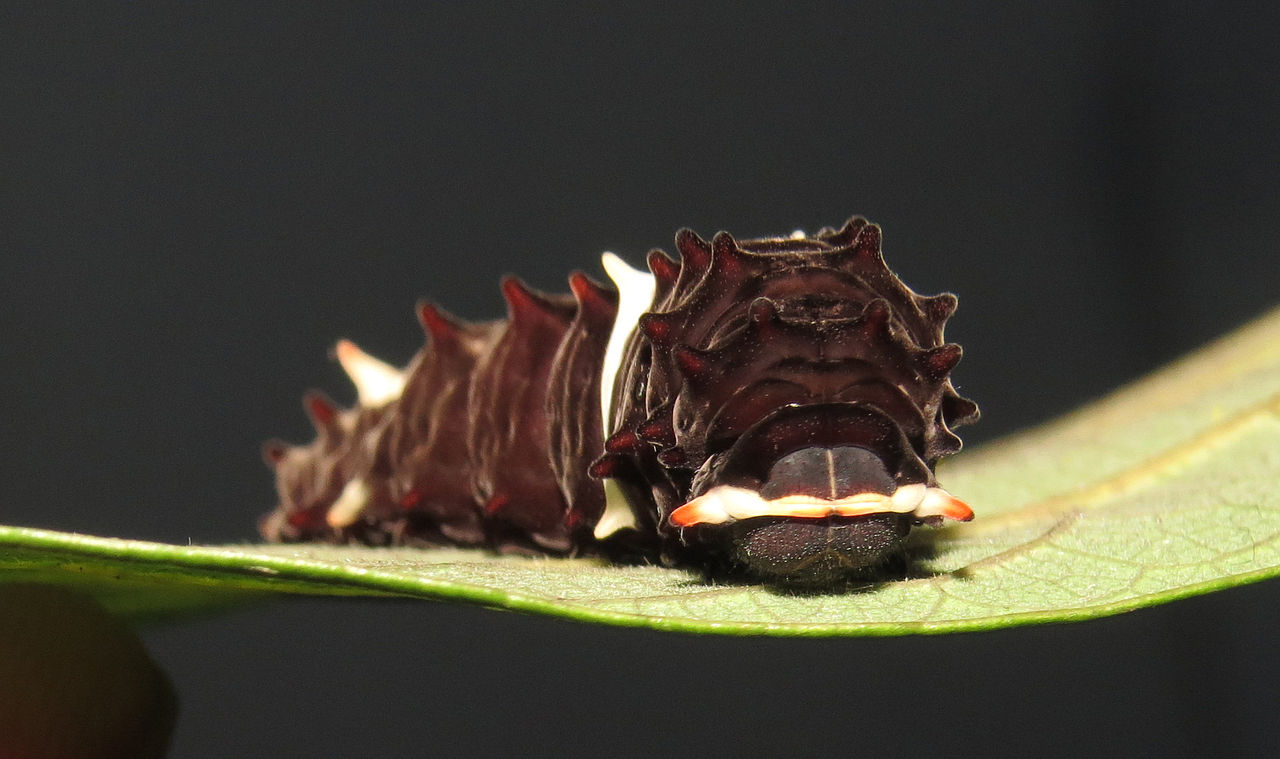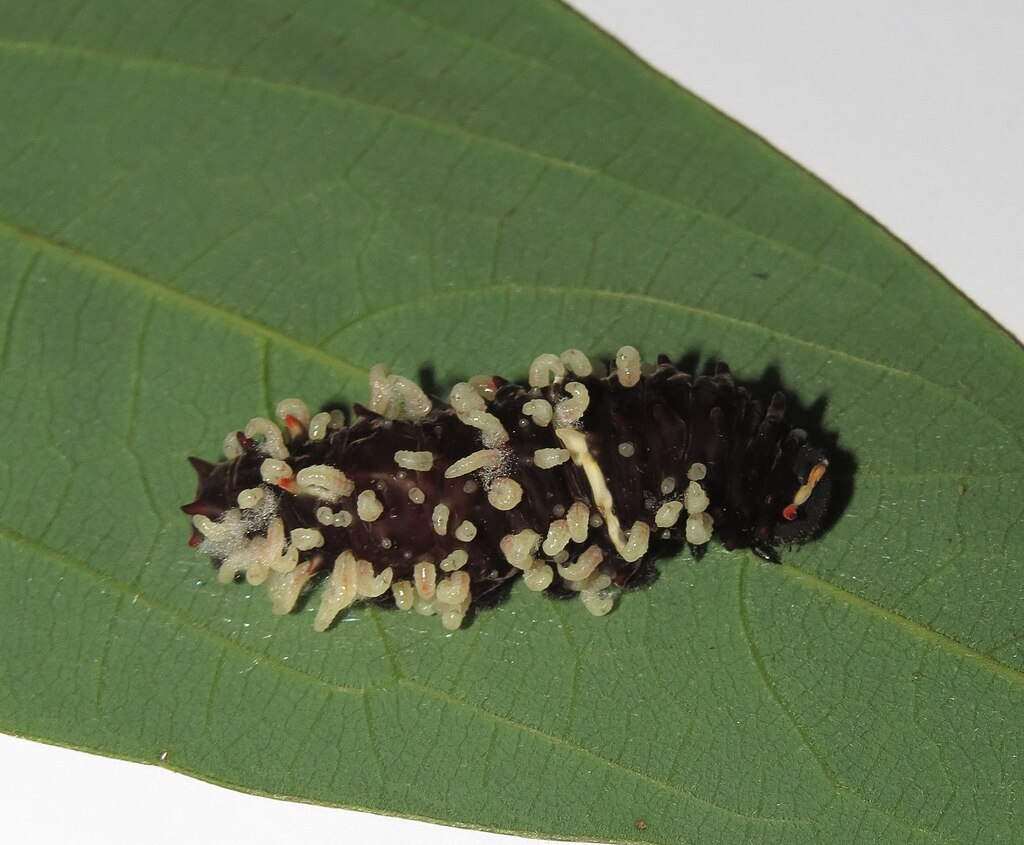All the Pachlioptas look somewhat alike, observes Christian Schulze, author of a mini-field-guide paper pointing out the differences among species in this genus:
A family resemblance can have benefits. Pachliopta pandiyana, the Malabar Rose, is described as a "species of least concern" about any danger of extinction, yet it is protected by law because of its resemblance to the endangered P. jophon.
The tradition in naming these butterflies, up to the twentieth century, was to name them after characters in history and literature who were associated with funerals, because fo their funereal black and sometimes white or grey wings. Pandiyan was an ancient Indian king. Today he's remembered more for having designed and partly built towns than for his funeral, but he undoubtedly had a big showy one.
Photo donated to Wikipedia By I, Nature Loader, CC BY-SA 3.0, https://commons.wikimedia.org/w/index.php?curid=2267105 .
The English gave it the nickname "Malabar Rose." It is common in several parts of southern India, including but by no means limited to Malabar. Some Indians call it the Kanana Rose, possibly from a word kanana, meaning forests or groves. It lives near forests, on hill slopes, not too high up.
The fore wings have that "black wing nerves" (Atrophaneura) look, dark grey veins and pearly grey to white between. Hind wings have a large white spot bordered by smaller spots that look grey or pinkish above, red below.. When the wings are spread to full "windmill" position pandiyana's white spots are much bigger than those of Atrophaneura aristolochiae, the Common Rose, or the rare, endangered Pachliopta jophon. The butterflies do not normally rest in this position and the three species look very similar to the average observer, most of the time. "Trafficking" dead specimens of pandiyana is thus restricted on the ground that selling these butterflies' bodies to "collectors" might increase the danger to jophon.
If you observe butterflies closely you will find dead butterflies easily enough, by going where your little friends have been a few weeks after eclosion (emergence from the pupal skin). Some butterflies normally fly for only ten days. Nevertheless, although chemists can get useful information from analyses of dead butterflies, the way we collect butterflies now is with cameras. A collection of carcasses will only fade and attract visits from a species of unattractive beetles that eat dead insects. A collection of photographs will actually communicate the beauty of the nature scenes it commemorates.
The Malabar Rose is less common than the Common Rose, but not considered terribly rare or endangered. It seems to share an ecological niche with the Common Rose. Areas tend to have one or the other. The Malabar Rose is most often seen in September and October. Some think it may have a one-year life cycle, though its life span is much shorter.
Even living butterflies fade with time.
Baby Malabar Roses start out as the usual tiny yellow-orange beads. As the eggs become ready to hatch the shell forms an orange dot--the skin is thinning on top, and the little red caterpillar inside is preparing to pop out. V.S. Revathy and George Matthews gathered some new-laid eggs and found that they hatched in four or five days.
Next, they spend about three weeks as caterpillars, growing through five instars during which their skins vary only slightly except in size. Their food plant is Thottea siliquosa. Caterpillars like to draw a leaf up around \themselves to form a shelter
The caterpillar looks like the other Atrophaneura larvae, except for the white bar across the front of the head. Relative to the animal's anatomy, this bar is like a headband; a caterpillar's face is turned toward what it's crawling on and/or eating.
Photo donated to Vietnamese Wikipedia by Bởi Vinayaraj – Tác phẩm được tạo bởi người tải lên, CC BY-SA 4.0, https://commons.wikimedia.org/w/index.php?curid=43424559. The bumps and bristles are shorter than some of the other Atrophaneuras at the same age, the white "belt" is conspicuous, and the head-on view resembles a miniature semitractor-trailer truck with its lights and bumper.
Photo donated Bởi Vinayaraj – Tác phẩm được tạo bởi người tải lên, CC BY-SA 4.0, https://commons.wikimedia.org/w/index.php?curid=43424567
Despite its toxicity to most predators, the caterpillar is vulnerable to smaller insects that lay eggs on its back end. The eggs hatch into larvae that burrow into the caterpillar to eat, then back out of its skin to pupate.
This caterpillar, also photographed by Vinayaraj, will not live to become a butterfly. Bởi Vinayaraj – Tác phẩm được tạo bởi người tải lên, CC BY-SA 4.0, https://commons.wikimedia.org/w/index.php?curid=123624978
But, if all goes well, they spend 15 to 18 days in pupation, turning into butterflies. A healthy caterpillar grows from a hatchling less than half a centimeter long to a final length of about four inches. A general rule, not true for some species, is that a caterpillar grows about as long as the adult moth's or butterfly's wingspan. This is true for pandiyana. Male butterflies' wingspan is about four inches, females' about four and a half.
K. Gopakumar (http://insectsofkerala.blogspot.com/2011/01/malabar-rose-butterfly.html) thought the pupa looked like a monkey's face. Vinayaraj demonstrates why. It has the same flattened, wilted-leaf look that other Atrophaneura pupae have, and the side facing out from the branch to which it's attached looks like this.
Like all butterflies, the adults don't seem to recognize their offspring if they ever see them. Female butterflies have strong instincts to find the right place for each egg. They touch and taste leaves. using their ability to taste with the soles of their feet, and select fresh, tender leaves a good distance from each other before laying one egg at a time.










No comments:
Post a Comment